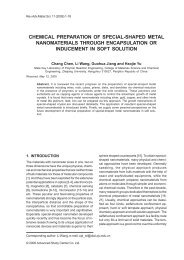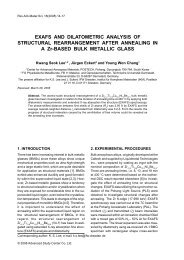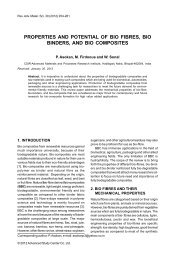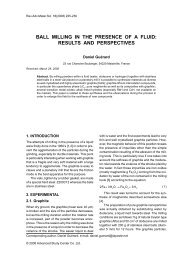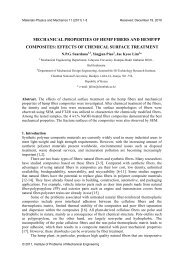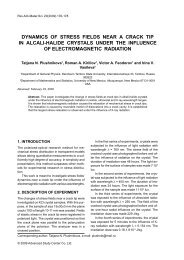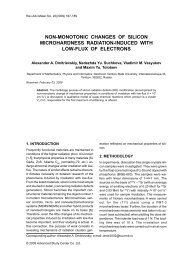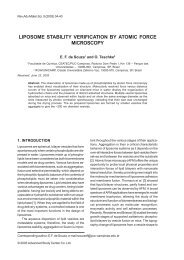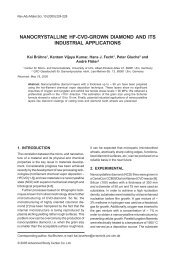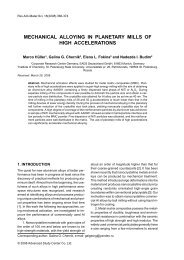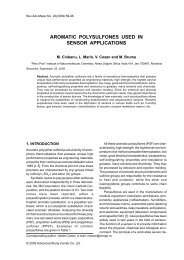surface pretreatment by phosphate conversion coatings – a review
surface pretreatment by phosphate conversion coatings – a review
surface pretreatment by phosphate conversion coatings – a review
You also want an ePaper? Increase the reach of your titles
YUMPU automatically turns print PDFs into web optimized ePapers that Google loves.
168 T.S.N. Sankara Narayanan<br />
ing the particle size of the dried sludge to less than<br />
about 20 mesh. The dried and ground <strong>phosphate</strong><br />
sludge has been found to be an excellent lubricant<br />
additive, which is suitable for use in lubricant formulations<br />
designed for the metal treatment, metal forming<br />
and industrial lubrication.<br />
United States Patent 4986977 [402] suggests a<br />
method for treating the phosphating sludge with an<br />
aqueous base to achieve a pH greater than 10 that<br />
results in precipitation of iron hydroxide. The iron<br />
hydroxide is recovered and the aqueous phase is<br />
acidified to a pH of 7-10 to cause precipitation of<br />
zinc hydroxide.<br />
Baldy [403] suggests that the phosphating<br />
sludge generated from automotive <strong>pretreatment</strong> process<br />
may contain up to 25 wt.% of oil and removal<br />
of oil is essential for the full recovery of all useful<br />
components. The removal of oil is accomplished <strong>by</strong><br />
the addition of H 2 O 2 to an acidic dispersion of the<br />
sludge that displaces the oil from the remaining<br />
mixture. According to him, the recovery of zinc <strong>phosphate</strong><br />
sludge involves the following four stages:<br />
Phase I is the separation of oil from the sludge.<br />
Phase II is the extraction of zinc, manganese and<br />
nickel from the sludge following digestion with phosphoric<br />
acid. Phase III is the <strong>conversion</strong> of the iron<br />
<strong>phosphate</strong> residue from phase II to pigment grade<br />
iron oxide and sodium <strong>phosphate</strong> that may be acidified<br />
to an iron <strong>phosphate</strong> concentrate.<br />
The use of phosphating sludge in the process of<br />
clinker production is suggested as one of the possible<br />
mode of reclamation of such waste <strong>by</strong> Caponero<br />
and Tenorio [404]. Their study proves that an addition<br />
of up to 7.0% of phosphating sludge to the raw<br />
cement meal of Portland cement did not cause any<br />
damage to the clinkerization process. X-ray diffraction<br />
analysis shows that there is no significant modification<br />
in the yielded clinker proportional to the<br />
sludge additions, neither is there atypical phases<br />
formed with additions up to 5.0% of phosphating<br />
sludge. Differential thermal analysis of the mixture<br />
with up to 7.0% dry sludge additions does not show<br />
any significant difference from the analysis of the<br />
cement clinker raw meal. Additions of the phosphating<br />
sludge up to 5.0% significantly modify only the<br />
zinc content of the clinker that was produced. The<br />
major element of the sludge, zinc, shows an average<br />
of incorporation of 75%.<br />
4. SUMMARY<br />
This <strong>review</strong> outlines the various aspects of phosphating.<br />
Although, numerous modifications were<br />
proposed recently, on the deposition technologies<br />
to achieve different types of <strong>coatings</strong> and desirable<br />
properties such as improved corrosion resistance,<br />
wear resistance, etc., <strong>phosphate</strong> <strong>conversion</strong> coating<br />
still plays a vital part in the automobile, process<br />
and appliance industries, as it has unique advantages<br />
in the cost-wise placement among all the<br />
emerging deposition technologies and pays off the<br />
finisher with a handful of profit.<br />
ACKNOWLEDGEMENT<br />
Financial support given <strong>by</strong> the Council of Scientific<br />
and Industrial Research, New Delhi, India, is gratefully<br />
acknowledged. The author expresses his sincere<br />
thanks to Dr.S. Srikanth, Scientist-in-charge,<br />
NML Madras Centre and Prof. S.P. Mehrotra, Director,<br />
National Metallurgical Laboratory,<br />
Jamshedpur, for their constant support and encouragement.<br />
REFERENCES<br />
[1] M.G. Fontana, Corrosion Engineering, 3 rd<br />
Edition (McGraw-Hill Book<br />
Company,Singapore, 1987).<br />
[2] U.R. Evans, An Introduction to Metallic Corrosion,<br />
3 rd Edition (Edward Arnold Publishers<br />
Ltd., London, 1981).<br />
[3] H.H. Uhlig, Corrosion and Corrosion Control,<br />
2 nd Edition (John Wiley & sons, Inc., New<br />
York, 1971).<br />
[4] F.L. La Que, In: Good Painting Practice, ed.<br />
<strong>by</strong> John D. Keane, Vol. 1, 2 nd Edition, (Steel<br />
Structures Painting Council, Pittsburgh, 1973)<br />
Chap. 1.1, p. 3.<br />
[5] Henry Leidheiser, Jr., In: Metals Handbook,<br />
Vol. 13, 9 th Edition (American Society of<br />
Metals, Ohio, 1987) p. 377.<br />
[6] J.W. Gailen and E.J. Vaughan, Protective<br />
Coatings for Metals (Charles Griffin & Co. Ltd.,<br />
1979) p. 97.<br />
[7] M.A. Kuehner // Met. Finish. 83 (1985) 17.<br />
[8] Ichiro Suzuki, Corrosion Resistant Coatings<br />
Technology (Marcel Dekker, Inc., New York,<br />
1989) p. 167.<br />
[9] Phosphorous and its Compounds, Vol. II, ed.<br />
<strong>by</strong> J.R. Van Wazer (Interscience Publishers<br />
Inc., New York, 1967) p. 1869.<br />
[10] W.A. Ross, British Patent 3,119 (1869).<br />
[11] T.W. Coslett, British Patent 8,667 (1906).<br />
[12] T.W. Coslett, British Patent 15,628 (1908).<br />
[13] T.W. Coslett, British Patent 22,743 (1909).<br />
[14] T.W. Coslett, British Patent 28,131 (1909).<br />
[15] R.G. Richard, British Patent 37,563 (1911).



